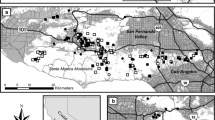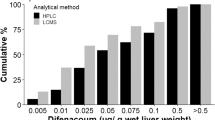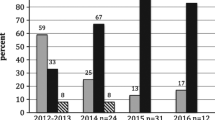Abstract
Anticoagulant rodenticides are widely used to control rodent infestations. Previous studies have shown that nontarget organisms, such as birds, are at risk for both primary and secondary poisoning. This paper presents rodenticide residue information on the livers from 164 strigiformes which included barn owls (Tyto alba), barred owls (Strix varia), and great horned owls (Bubo virginianus), collected from 1988 to 2003 in the province of British Columbia and the Yukon Territory, Canada. Livers were analyzed for brodifacoum, bromadiolone, chlorophacinone, diphacinone, difethialone, and warfarin. Our results show that, of the 164 owl livers analyzed, 70% had residues of at least one rodenticide, and of these 41% had more than one rodenticide detected. Of the three species of owls examined, barred owls were most frequently exposed (92%, n = 23); brodifacoum and bromadiolone were most often detected, with liver concentrations ranging from 0.001 to 0.927 mg/kg brodifacoum, and 0.002 to 1.012 mg/kg bromadiolone. Six of the owls (three barred owls, two barn owls, and one great horned owl) were diagnosed as having died from anticoagulant poisoning; all six owls had brodifacoum residues in the liver.




Similar content being viewed by others
References
Anderson GG, Kluge HA (1986) Rodent control on agricultural land in British Columbia. Ministry of Agriculture and Food, Canada
British Columbia Ministry of Agriculture, Food and Fisheries (1996) Control of rats and mice on poultry farms. http://www.agf.gov.bc.ca/resmgmt/publist/300series/384200-6.pdf
Buckle AP, Prescott CV, Ward KJ (1994) Resistance to the first and second generation anticoagulant rodenticides – a new perspective. In: Halverson WS, Marsh RE (eds) Proceedings of the sixteenth vertebrate pest conference, pp 138–144
Campbell RW, Dawe NK, McTaggart-Cowan I, Cooper JM, Kaiser GW, McNall MCE (1990) Birds of British Columbia, vol II Nonpasserines. Royal British Columbia Museum, Victoria, pp 353–375
Campbell EC, Campbell RW (1984) COSEWIC status report on the Barn Owl Tyto alba in Canada. Committee on the Status of Endangered Wildlife in Canada. 77 pp
COSEWIC (2001) COSEWIC assessment and update status report on the Barn Owl Tyto alba in Canada. Committee on the Status of Endangered Wildlife in Canada, Ottawa, vii + 11 pp
Cox P, Smith RH (1992) Rodenticide ecotoxicology: pre-lethal effects of anticoagulants on rat behaviour. In: Borrecco JE, Marsh RE (eds) Proceedings of the 15th vertebrate pest conference. University of California, Davis, California, USA. pp 165–170.
Eason CT, Murphy E, Wright GR, Spurr EB (2002) Assessment of risks of brodifacoum to non-target birds and mammals in New Zealand. Ecotoxicology 11:35–48
Eason CT, Ogilvie S, Miller A, Henderson R, Shapiro L, Hix S, MacMorran D (2008) Smarter pest control tools with low residue and humane toxins. In: Timms RM, O'Brien JM (eds) Proceedings of the 23rd vertebrate pest, San Diego, pp 148–153. University of California, Davis, CA, USA
Environment Canada and Ministry of Water, Land and Air Protection (2005) Survey of pesticide use in British Columbia: 2003. Prepared by ENKON environmental limited project no. 1004-011
Fisher P, O’Connor C, Wright G, Eason CT (2003) Persistence of four anticoagulant rodenticides in the livers of laboratory rats. Department of Conservation Science Internal Series 139, New Zealand
Hegdal PL, Colvin BA (1988) Potential hazard to eastern screech-owls and other raptors of brodifacoum bait used for vole control in orchards. Environ Toxicol Chem 7:245–260
Hindmarch S. How does land use influence the distribution and breeding success of barn owl (Tyto alba) in the lower mainland, British Columbia. Simon Fraser University, M Sc (in prep)
Howald GR, Mineau P, Elliott JE, Cheng KM (1999) Brodifacoum poisoning of avian scavengers during rat control on a seabird colony. Ecotoxicology 8:431–447
Laas FY, Forss DA, Godfrey MER (1985) Retention of brodifacoum in sheep tissues and excretion in faeces. New Zeal J Agr Res 28:357–359
LiphaTech Inc. (2007) Maki Parafanized pellets material safety data sheet (PCP Registration No. 20258). LiphaTech Inc, 3600 W. Elm Street, Milwaukee, WI 53209
Mendenhall VM, Pank LF (1980) Secondary poisoning of owls by anticoagulant rodenticides. Wildlife Soc B 8(4):311–315
Merson MH, Byers RE, Kaukeinen DE (1984) Residues of the rodenticide brodifacoum in voles and raptors after orchard treatment. J Wildlife Manage 48:212–216
Newton I, Wyllie I, Freestone P (1990) Rodenticides in British barn owls. Environ Pollut 68:101–117
Newton I, Dale L, Finnie JK, Freestone P, Wright J, Wyatt C, Wyllie I (1998) Wildlife and pollution: 1997/98 Annual Report. JNCC Report No. 285
Newton I, Shore RF, Wyllie I, Birks JDS, Dale L (1999) Emperical evidence of side-effects of rodenticides on some predatory birds and mammals. In: Cowan DP, Feare CJ (eds) Advances in vertebrate pest management. Filander Verlag, Furth, pp 347–367
Newton, I, Afsar A, Dale L, Finnie J, Shore R F, Wright J, Wyatt C, Wyllie I (2000) Wildlife and pollution: 1998/99 annual report. JNCC report, No. 305
Parmar G, Bratt H, Moore R, Batten PL (1987) Evidence for a common binding-site in vivo for the retention of anticoagulants in rat liver. Hum Toxicol 6:431–432
Pest Management Regulatory Agency (2006) Reevaluation decision: brodifacoum, bromodiolone, chlorophacinone, diphacinone and warfarin. Health Canada, Ottawa, Ontario
Stone WB, Okoniewski JC, Stedelin JR (1999) Poisoning of wildlife with anticoagulant rodenticides in New York. J Wildlife Dis 35(2):187–193
Stone WB, Okoniewski JC, Stedelin JR (2003) Anticoagulant rodenticides and raptors: recent findings from New York, 1998–2001. B Environ Contam Tox 70:34–40
US EPA (2004) Potential risks of nine rodenticides to birds and nontarget mammals: a comparative approach. Washington DC, USA
Vandenbroucke V, Bousquet-Melou A, De Backer P, Croubles S (2008) Pharmacokinetics of eight anticoagulant rodenticides in mice after single oral administration. J Vet Pharmacol Ther 31:437–445
Walker LA, Turk A, Long SM, Wienburg CL, Best J, Shore RF (2008) Second generation anticoagulant rodenticides in tawny owls (Strix aluco) from Great Britain. Sci Total Environ 392:93–98
Acknowledgements
We thank the following agencies for submitting owl carcasses to our agency: the British Columbia Ministry of Environment including Karen Morrison in Nanaimo, Jack Evans in Surrey, and Orville Dyer in Penticton as well as all Conservation Officers throughout B.C.; the Yukon Department of Renewable Resources (Bruce Bennett); Orphaned Wildlife Rehabilitation Society (OWL), Monika’s Wildlife Shelter, Wildlife Rescue Association (WRA), North Island Wildlife Recovery Association (NIWRA), Mountainaire Avian Rescue Society (MARS), South Okanagan Rehabilitation Center for Owls (SORCO), and Fur and Feather Taxidermy. Sandi Lee is thanked for her assistance with field studies. National Wildlife Research Centre staff are thanked for specimen bank archiving and rodenticide residue analysis. Thanks are extended to Dr. Malcolm McAdie and Craig Stephens and staff at the Centre for Coastal Health for conducting post mortem examinations. Funding was from the Canadian Wildlife Service and the Pesticide Science Fund of Environment Canada.
Author information
Authors and Affiliations
Corresponding author
Rights and permissions
About this article
Cite this article
Albert, C.A., Wilson, L.K., Mineau, P. et al. Anticoagulant Rodenticides in Three Owl Species from Western Canada, 1988–2003. Arch Environ Contam Toxicol 58, 451–459 (2010). https://doi.org/10.1007/s00244-009-9402-z
Received:
Accepted:
Published:
Issue Date:
DOI: https://doi.org/10.1007/s00244-009-9402-z




